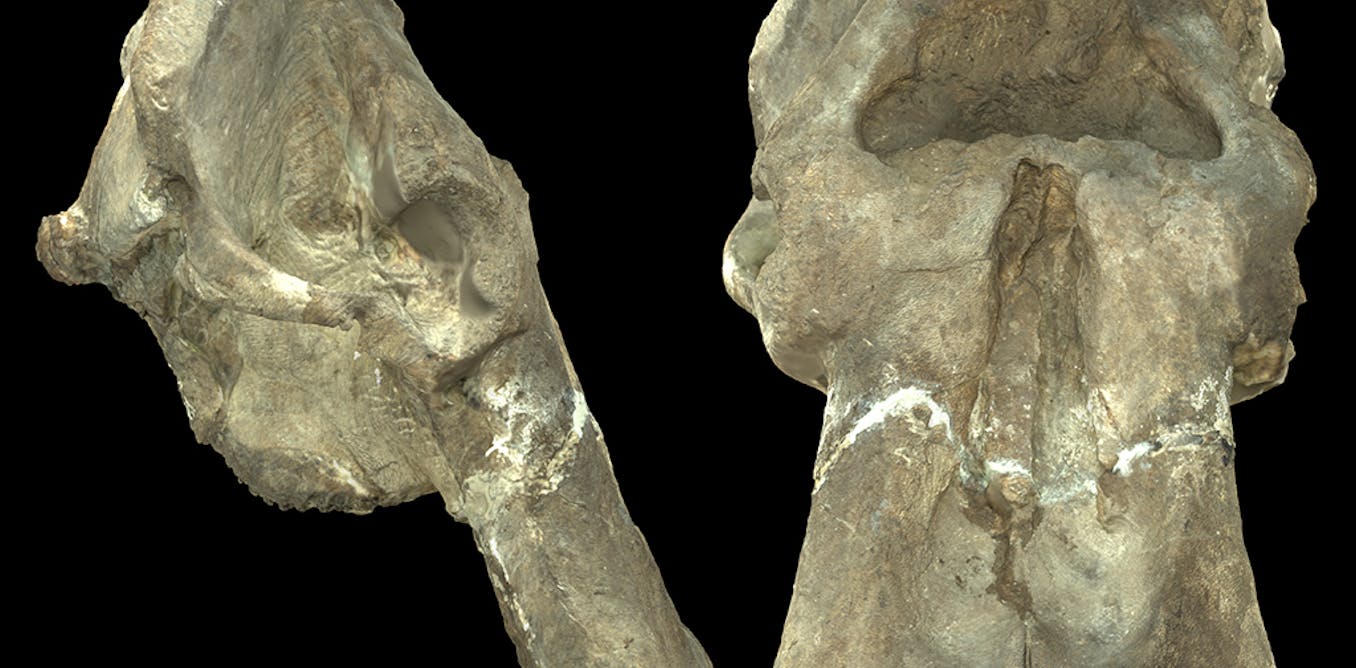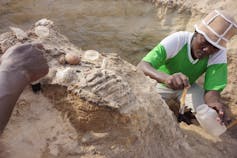A fossil cranium from Kenya tells the story of an extinct elephant species
The anatomy of the teeth in the cranium and its bones show that it belongs to an extinct cousin of the living African savanna and forest elephants.


Some 4.5 million years ago, during the early Pliocene epoch, Kenya’s Lake Turkana looked very different than it does today. Grasslands and open woodlands were spreading in cooler, drier climates. Competition for C4 grasses – the kind that grow in seasonal, tropical environments and were well adapted for these new, cooler, drier conditions – was increasing between mammals like horses, hippos, rhinos, antelopes, pigs and elephants. Some of the oldest bipedal human ancestors, Australopithecus anamensis, inhabited the same landscapes.
Flash forward to 2013. Apolo Longaye, a member of the Koobi Fora Research Project, was prospecting the barren landscape for fossils at a site known as Area 14, northeast of Lake Turkana near Ileret, Kenya. Longaye spotted a single fossil elephant molar beginning to emerge from the ground. Project leaders Meave Leakey and Louise Leakey decided to excavate the molar. They discovered an entire cranium to which the molar belonged.
What followed was a remarkable collaborative effort by researchers in Kenya and the US to recover, prepare, conserve, and study the cranium and its geological context.
The results of the study, which I led, reveal the cranium to be truly extraordinary. It belonged to an adult male that was still growing at the time of its death. It is much larger than the biggest crania of living African elephants, correlating with a body size of about 3.7 metres from the ground to the top of the shoulder and weight of about about 8000 kgs. Its degree of preservation makes it the only nearly complete cranium of an elephant to have been found in an interval from their origin at about 8 million years to about 3.5 million years ago.
The anatomy of the teeth in the cranium and its bones show that it belongs to Loxodonta adaurora, an extinct cousin of the living African savanna and forest elephants. It is also called the “dawn African elephant.”
This is an important finding because, by studying its teeth, we were able to understand how this species physically shaped the landscape it occupied. It also gives us new insight into an ancient species whose modern cousins remain a part of our lives - for now, given that they are on the verge of extinction.
Recovery and study
The first step in recovering the immense fossil elephant cranium – it weighs more than 1800kgs – involved excavating it. It was then treated with chemical preservative in the field, and secured inside a plaster-and-burlap cradle on a metal frame. After this it was removed from the local sediments and hoisted onto the back of a truck, aided by many of the project’s team members.
[courtesy of Louise Leakey, Turkana Basin Institute and National Geographic Explorer-at-Large]]
It was taken to the Turkana Basin Institute’s Ileret research facility for permanent storage. There, it underwent initial preparation and further chemical consolidation. This made the fossil accessible for study.
Meanwhile, geologists from the Universities of Utah and Rutgers studied the rock sequence in Area 14. They wanted to establish the age of the fossil and the geological context it was recovered from. They also wanted to determine the conditions under which the elephant cranium had become fossilised. Their investigations revealed that the rocks from which the cranium was extracted were sandstones and conglomerates that had accumulated in an ancient river. Bones have a better chance of becoming fossils if they are quickly covered by sediments in lakes or rivers. There work established that the cranium is as old as 4.5 million years.
Once this work was done, I undertook comparative research on the cranium. This was designed to identify and properly describe it for publication. I have studied the evolution and palaeoecology of African and Arabian elephants and their closest relatives for almost 40 years, involving fieldwork and investigations of fossil collections in museums from Cairo to Cape Town.

The cranium was measured in the Ileret facility using animal body calipers. It is almost 1400 mm long and over 900 mm wide. It was also scanned in Kenya to make 3D images, which allowed me to look at the cranium in its entirety at the same time, remotely. [add the video of the cranium in mp4 file, courtesy of Louise Leakey]
Built for the task
We did more than just identify the elephant species and locate it in geographical time. By studying its molars and cranium, the team was also able to understand the animal’s chewing habits. It possessed abundant adaptations for resisting the grit of eating close to the ground and for an energy-efficient form of horizontal-shearing when chewing.
We found that the teeth of Loxodonta adaurora are higher-crowned and more abundantly covered with protective cementum (in human teeth this hard substance covers the roots; in elephants it extends up over the crown of molars) than the molars of earlier elephants. The details of the new cranium also show that it is unexpectedly modern in shape: tall and compressed from front-to-back, an expedient arrangement to align the chewing muscles perfectly to apply their force for grazing.
The advantages of having anatomy synchronised with feeding behaviour go a long way to explaining why Loxodonta adaurora was the dominant elephant known in eastern Africa at that time, particularly in the region around what is now Lake Turkana: it was perfectly built for the landscape of the time.
Other species benefited from living in habitats opened up by elephant feeding and movement activities. Elephants opened up closed woodlands and forests to transform them into grasslands and open woodland, wooded savannas and brushland.
In these conditions, an “ape” that adopted walking on two legs became energy efficient to travel between patches of fruit trees and other resources. Nascent bipedality in early hominins was perfect for these conditions; without these conditions, bipedality would have conferred no particular advantage and humans may not have continued to evolve into the tool-making bipeds we are today.
Looming extinction
It seems tragic that the current relatives of this Pliocene behemoth, and with them the lineage that once created conditions for the early success of our own evolution, now also face extinction – not because of natural competition but due to avoidable human land encroachment, poaching, and the environmental impacts of human-driven climate change.![]()
William Sanders does not work for, consult, own shares in or receive funding from any company or organization that would benefit from this article, and has disclosed no relevant affiliations beyond their academic appointment.
What's Your Reaction?






























































































